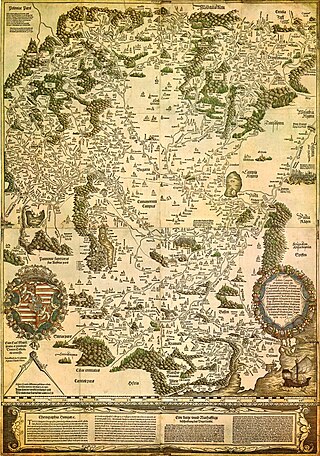Related Research Articles

The Dacians were the ancient Indo-European inhabitants of the cultural region of Dacia, located in the area near the Carpathian Mountains and west of the Black Sea. They are often considered a subgroup of the Thracians. This area includes mainly the present-day countries of Romania and Moldova, as well as parts of Ukraine, Eastern Serbia, Northern Bulgaria, Slovakia, Hungary and Southern Poland. The Dacians and the related Getae spoke the Dacian language, which has a debated relationship with the neighbouring Thracian language and may be a subgroup of it. Dacians were somewhat culturally influenced by the neighbouring Scythians and by the Celtic invaders of the 4th century BC.

The Thracians were an Indo-European speaking people who inhabited large parts of Southeast Europe in ancient history. Thracians resided mainly in Southeast Europe in modern-day Bulgaria, Romania and northern Greece, but also in north-western Anatolia in Turkey.

The Agathyrsi were an ancient people belonging to the Scythian cultures who lived in the Transylvanian Plateau next to the Sigynnai and Sindos, in the region that later became Dacia. The Agathyrsi are largely known from Herodotus of Halicarnassus's description of them in the 5th century BC.

The Wessex culture is the predominant prehistoric culture of central and southern Britain during the early Bronze Age, originally defined by the British archaeologist Stuart Piggott in 1938.
The International Union for Prehistoric and Protohistoric Sciences (IUPPS) is a learned society, linked through the International Council for Philosophy and Humanistic Studies to UNESCO, and concerned with the study of prehistory and protohistory. In the words of its constitution:

The history of Hungarybefore the Hungarian conquest spans the time period before the Hungarian conquest in the 9th century of the territories that would become the Principality of Hungary and the Kingdom of Hungary.

The Getae or Gets were a Thracian-related tribe that once inhabited the regions to either side of the Lower Danube, in what is today northern Bulgaria and southern Romania. Although it is believed that the Getae were related to their westward neighbours, the Dacians, several scholars, especially in the Romanian historiography, posit that the Getae and the Dacians were the same people.

Charles Francis Christopher Hawkes, FBA, FSA was an English archaeologist specialising in European prehistory. He was Professor of European Archaeology at the University of Oxford from 1946 to 1972.
Historiography is the study of how history is written. One pervasive influence upon the writing of history has been nationalism, a set of beliefs about political legitimacy and cultural identity. Nationalism has provided a significant framework for historical writing in Europe and in those former colonies influenced by Europe since the nineteenth century. Typically official school textbooks are based on the nationalist model and focus on the emergence, trials and successes of the forces of nationalism.

The Decebalus treasure is an account detailed by Cassius Dio about events said to have happened in the Roman world during the 2nd century AD.

The prehistory of Southeastern Europe, defined roughly as the territory of the wider Southeast Europe covers the period from the Upper Paleolithic, beginning with the presence of Homo sapiens in the area some 44,000 years ago, until the appearance of the first written records in Classical Antiquity, in Greece. First Greek language is Linear A and follows Linear B, which is a syllabic script that was used for writing in Mycenaean Greek, the earliest attested form of the Greek language. The script predates the Greek alphabet by several centuries. The oldest Mycenaean writing dates to about 1400 BC. It is descended from the older Linear A, an undeciphered earlier script used for writing the Minoan language, as is the later Cypriot syllabary, which also recorded Greek. Linear B, found mainly in the palace archives at Knossos, Kydonia, Pylos, Thebes and Mycenae, but disappeared with the fall of the Mycenean civilisation during the Late Bronze Age collapse.
Midianite pottery, also known as Qurayya ware is a ware type found in the Hejaz, southern and central Jordan, southern Palestine and the Sinai, generally dated to the 13th-12th centuries BCE, although later dates are also possible.

Prehistory, also called pre-literary history, is the period of human history between the first known use of stone tools by hominins c. 3.3 million years ago and the beginning of recorded history with the invention of writing systems. The use of symbols, marks, and images appears very early among humans, but the earliest known writing systems appeared c. 5,200 years ago. It took thousands of years for writing systems to be widely adopted, with writing spreading to almost all cultures by the 19th century. The end of prehistory therefore came at different times in different places, and the term is less often used in discussing societies where prehistory ended relatively recently.

The appearance of Celts in Western Romania can be traced to the later La Tène period . Excavation of the great La Tène necropolis at Apahida, Cluj County, by S. Kovacs at the turn of the 20th century revealed the first evidence of Celtic culture in Romania. The 3rd–2nd century BC site is remarkable for its cremation burials and chiefly wheel-made funeral vessels.

The Golden Helmet of Coțofenești is a Geto-Dacian helmet dating from the first half of the 4th century BC.

The Helmet of Iron Gates is a Geto-Dacian silver helmet dating from the 4th century BC, housed in the Detroit Institute of Arts, United States.
Dacian art is the art associated with the peoples known as Dacians or North Thracians; The Dacians created an art style in which the influences of Scythians and the Greeks can be seen. They were highly skilled in gold and silver working and in pottery making. Pottery was white with red decorations in floral, geometric, and stylized animal motifs. Similar decorations were worked in metal, especially the figure of a horse, which was common on Dacian coins.
The Antiquity in Romania spans the period between the foundation of Greek colonies in present-day Dobruja and the withdrawal of the Romans from "Dacia Trajana" province. The earliest records of the history of the regions which now form Romania were made after the establishment of three Greek towns—Histria, Tomis, and Callatis—on the Black Sea coast in the 7th and 6th centuries BC. They developed into important centers of commerce and had a close relationship with the natives. The latter were first described by Herodotus, who made mention of the Getae of the Lower Danube region, the Agathyrsi of Transylvania and the Sygannae of Crişana.

Prehistoric religion is the religious practice of prehistoric cultures. Prehistory, the period before written records, makes up the bulk of human experience; over 99% of human experience occurred during the Paleolithic period alone. Prehistoric cultures spanned the globe and existed for over two and a half million years; their religious practices were many and varied, and the study of them is difficult due to the lack of written records describing the details of their faiths.
References
- ↑ Bahn, Paul (ed.) The Penguin Archaeology Guide Penguin Books Ltd (29 Nov 2001) ISBN 978-0-14-029308-1 p. 368
- ↑ Cunliffe, Barry (2001). The Oxford Illustrated History of Prehistoric Europe. Oxford: Oxford University Press. ISBN 978-0-19-285441-4.
- ↑ Taylor, Timothy (1994). "Thracians, Scythians and Dacians". In Cunliffe, Barry (ed.). The Oxford Illustrated Prehistory of Europe . Oxford: Oxford University Press. pp. 373–410. ISBN 978-0-19-814385-7.
- ↑ Timothy Taylor (2001). "Believing the Ancients: Quantitative and Qualitative Dimensions of Slavery and the Slave Trade in Later Prehistoric Eurasia". World Archaeology. 33 (1). World Archaeology, Vol. 33, No. 1, The Archaeology of Slavery (Jun., 2001), pp. 27–43: 27–43. doi:10.1080/00438240120047618. JSTOR 827887. S2CID 162250553.
- ↑ Fagan, Brian (2005). Ancient North America: The Archaeology of a Continent (4th ed.). London: Thames & Hudson. ISBN 978-0-500-28532-9.
- ↑ Nayeem, Muhammed Abdul, ed. (1990). Prehistory and Protohistory of the Arabian Peninsula (5 volumes). Hyderabad: Hyderabad Pub.
- ↑ "Alani". Encyclopædia Britannica. Retrieved March 12, 2016.
- ↑ Herodotus. "The Histories". Sacred Texts.
- ↑ Sultzman, Lee. "Erie". Dick Shovel.
- ↑ "Gaul - World History Encyclopedia". World History Encyclopedia .
- ↑ Van Rhyn, G. A. F. (1879). . The American Cyclopædia . Vol. VII.
- ↑ Maenchen-Helfen, Otto J. (1973). Max Knight (ed.). The World of the Huns: Studies in Their History and Culture. University of California Press. ISBN 0-520-01596-7.
- ↑ Kōzō, Yamamura; John Whitney Hall (1997). The Cambridge history of Japan. Cambridge University Press.
- ↑ "Mid-America : an historical review". Internet Archive. p. 228. Retrieved 2015-07-16.
- ↑ "Where are the Susquehannock". The Susquehannock Fire Ring. Archived from the original on 9 January 2010. Retrieved 13 March 2016.